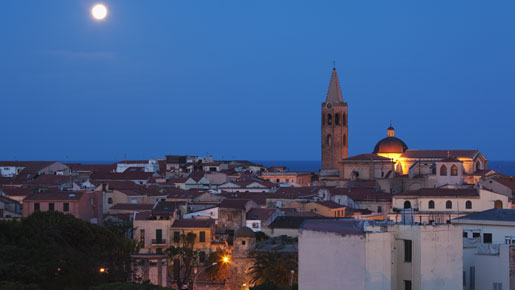
A sapphire sea washes against the wide walls and ancient fortifying towers that encase a medieval Citadel of buttery sandstone. Alghero’s centro storico, its atmospheric Old Town, is the most picturesque in all of Sardinia. A walk along its promenade ramparts reveals vistas of green headlands, sweeping bays and long sandy beaches. Spanish-style palazzos and street signs in Italian and Catalan reflect the city’s heritage – 400 years of Aragonese and Spanish rule. Catalan has been spoken here since the 13th century.
Slim campanile bell towers rise above a red-roofed town of tall, tightly packed houses where washing is strung beneath shuttered windows and tiny roof gardens bloom in the sunshine. Peeling stucco reveals the ancient stone of buildings inhabited for 800 years. Boutiques, bars and restaurants pack into narrow streets. Café tables, shaded by stylish cream umbrellas, spill out onto pretty cobbled piazzas and sea-view fish restaurants line the ramparts.
Although the historic centre feels very much like an old Italian town, many of the
buildings have a feisty Spanish flourish. The late-medieval Palazzo d’Albis, a highlight of Catalan architecture, oversees the busy Piazza Civica. Beneath its arched windows, smart cafés set out their tables, queues form for the best ice cream in town, and on the last Saturday of the month, bargain hunters and collectors gather for the art, crafts and antiques market.
Alghero is famous for the glowing, deep red coral found off the nearby Riviera del
Corallo coast. Fishing for the coral is strictly regulated – and jewellery created from the real thing doesn’t come cheap. Feast your eyes on the finest at Marogna, tucked discreetly into the Palazzo d’Albis, and seek out the jewellery designers working in small ateliers amid the maze of little streets to see some imaginative modern designs incorporating the ‘blood-red gold’.
A feast of fish
The food is another good reason to visit. Famed for its rock lobsters, Alghero is a treat for lovers of fresh fish and seafood – though meat-eaters fare well, too – and its cultural mix makes for some excellent and more unusual dishes. Lobster alla Catalana, cooked with locally grown tomatoes, onions and olive oil, is delicious; the paella is authentic; and crema catalanya (a relation of crème caramel) appears on every menu. But Sardinia is Italian: the pasta is terrific.
Salami and pecorino cheese are produced locally. Local honey appears on desserts – try gattò, made from almonds, honey and orange peel, also the cream cheese, lemon and honey fritters called seadas. Well-respected wines, and Anghelu Rùja port, are produced close to the town, and the prestige winery Sella e Mosca offers tours of its museum and wine cellar. Naturally it has a well-stocked shop, too.
Alghero is still a working fishing port, but the boats that line up in the busy marina at the
foot of the city walls are mainly of the sailing variety. This is a good coast for water sports and diving, and there are plenty of skippered yachts for hire. Tour boats leave the quay for Neptune’s Grotto, sailing along the dramatic coastline to the sheer cliffs and towering limestone headlands of the Capo Caccia promontory. At the caves, a 45-minute tour follows the long snaking passage deep into the rock to view dramatically lit, fantastical stalagmite and stalactite formations.
The real magic of Alghero comes with the sunset. To stroll along the walls, or sit at a bar and see the old city’s buildings glow a peachy-apricot colour as the sun sinks in a fiery ball across the bay, is a special experience. Get an outdoor table at one of the rampart restaurants, to dine by flickering candlelight, and the romance is complete.

